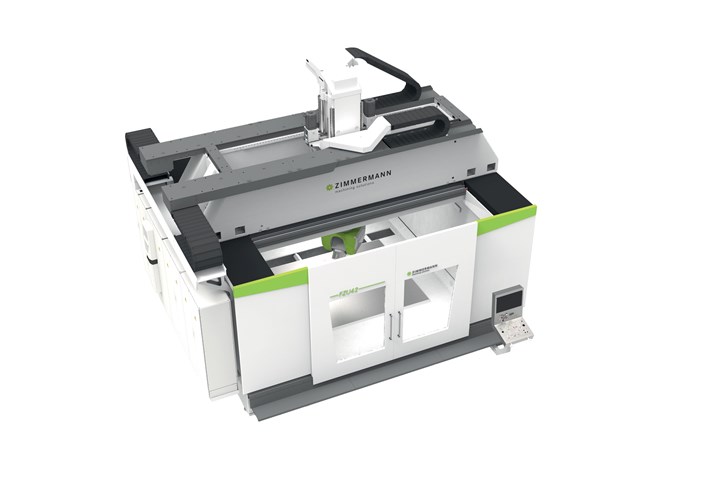Dynamic Milling Machine Design Improved for Heavy Machining
Zimmerman modifies its five-axis FZU/FZP42 machine line with features like a thermo-symmetrical design and centrally guided Z-slide to efficiently process large workpieces more dynamically and productively.
With the FZU/FZP42 machine line, Zimmermann Inc. offers users efficient five-axis portal milling machines for heavy workpiece machining. The improved machines feature a thermo-symmetrical design and incorporate a centrally guided Z-slide, all of which increases machine stability and saves on weight — resulting in a more dynamic, productive and energy-efficient machine.
“We are focusing less on classic heavy machining, using large tools and high material removal rates per cut,” says Cornelius Kiesel, president at Zimmermann Inc. in Detroit, the U.S. operation of F. Zimmermann in Germany. “Instead, the FZU/FZP42 model range provides tool and moldmakers with a five-axis system for highly complex components, which enables more dynamic milling of free-form surfaces.”
How can Zimmerman’s large machine design deliver great dynamics, so that users can work even more productively? “Our machines mill out contours with a maximum speed of 60 m/min and may accelerate with 3 m/s2, if needed,” says Kiesel. Despite the acceleration, the machines must be able achieve very high accuracy as well as high-quality surfaces.
Zimmermann’s answer is to set up its complete machine portfolio with a thermo-symmetrical design, which is based on the ability to substantially absorb incurring thermal influences, achieved by the design of the machine structure itself. Considering this factor, Zimmermann engineering has appropriately designed and intelligently arranged the machine structure and drive unit components and guides, as well as other components responsible for accuracy. In this way, the machine structure may expand in directions that are non-critical.
The centrally guided Z-slide of the portal in double-bridge construction has a large cross-section which makes it especially stable. Using this design, Zimmermann achieves a high degree of rigidity. Since there is no possible one-sided temperature rise, accuracy is greatly increased, as well. “Moving less mass also requires less energy. This results in clear cost benefits,” states Kiesel.
Among Zimmerman’s new customers is an automotive manufacture who required a new machine for its toolmaking, in order to process large sheet-metal forming tools and to replace older systems.
RELATED CONTENT
-
High-Performance Gantry Milling Systems
IMTS22: Zimmerman showcases three new gantry machines that enable dynamic roughing while maintaining high precision.
-
The Benefits of Hand Scraping
Accuracy and flatness are two benefits of hand scraping that help improve machine loop stiffness, workpiece surface finish and component geometry.
-
Gantry Machines Meet Industry-Specific Requirements for Mold and Die Makers
Zimmerman is putting on a virtual display of its highly rigid and efficient FZ42, FZ37 and FZ32 machines at IMTS 2022.








.jpg;maxWidth=970;quality=90)




